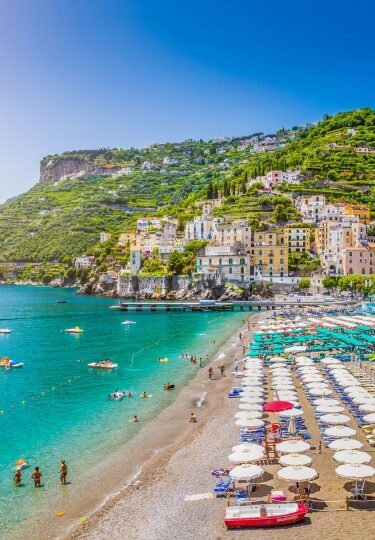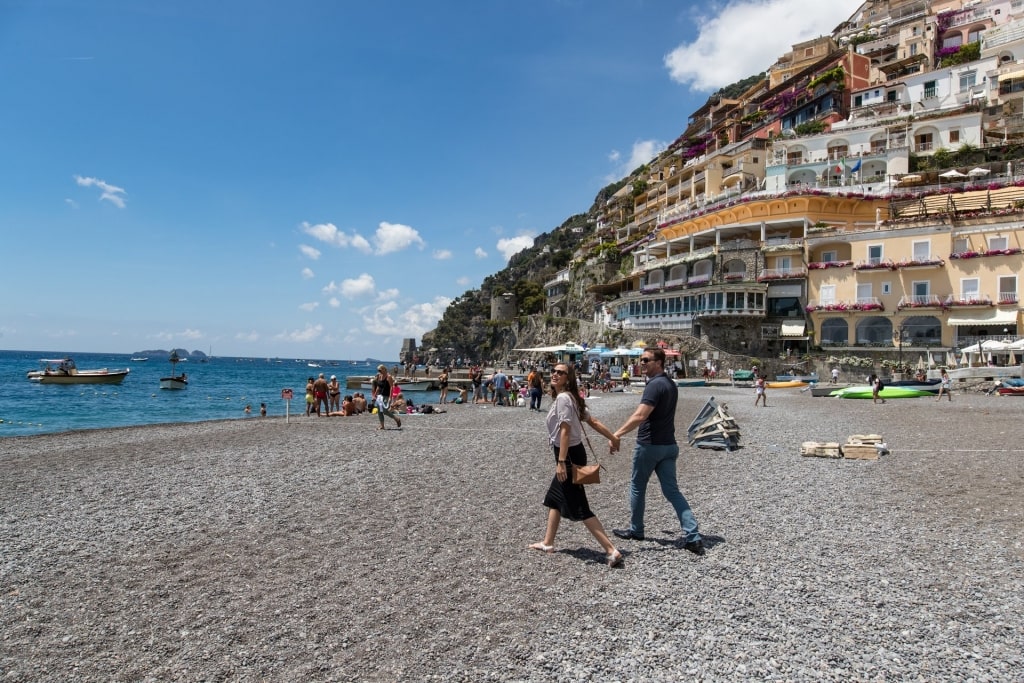The best beaches in Italy are shared fairly evenly between the famously boot-shaped mainland and its attendant islands. Washed by the Adriatic, Ionian, and Tyrrhenian Seas, Italy’s beaches benefit from mild waters and waves strong enough only to bronze the sand or sizzle out through the pebbles. Its translucent water is suffused with turquoise and adds emerald and sapphire hues as you wade in deeper.
But what truly elevates Italy’s beaches are their locations. From secluded hideaways tucked beneath a pastel-colored fishing village to sandy stretches juxtaposed against stunning natural phenomena, here’s a list of the best beaches in Italy.
Monterosso al Mare, Cinque Terre
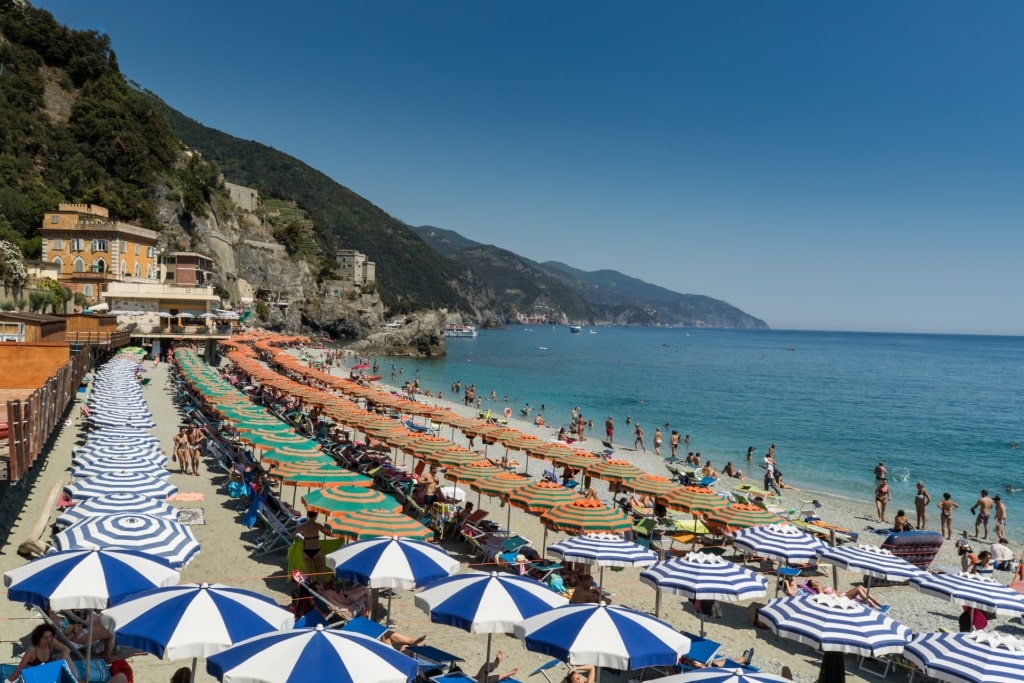
Monterosso al Mare, Cinque Terre
The Cinque Terre, a series of spectacular fishing villages that appear to have grown organically out of the rough Ligurian cliffs they’re set into, are not particularly known for their generally small, sharply upholstered beaches. Except, that is, for Monterosso al Mare.
The largest of Cinque Terre’s seaside villages, Monterosso offers a long, sandy beach with rocks jutting out from impressively azure waters. As the only significant beach in one of Italy’s most high-profile destinations, Monterosso features many colorful loungers and parasols alongside the usual accouterments you’d expect to find at a popular Italian seaside resort.
You’ll find it easy to unwind while ensconced by wild cliffs blanketed in a vertical patchwork of bright architecture and terraced gardens. Enjoy the cool breeze carrying the scent of Monterosso’s many lemon trees as it makes its way through the air.
Or maybe you’re smelling the lemon squeezed over your cone of takeout calamari from Il Bocconcino? Either way, dig your toes into the warm sand and enjoy one of the unmissable things to do in Cinque Terre—watch the spectacular sunset.
Marina di Alberese, Maremma National Park, near Civitavecchia
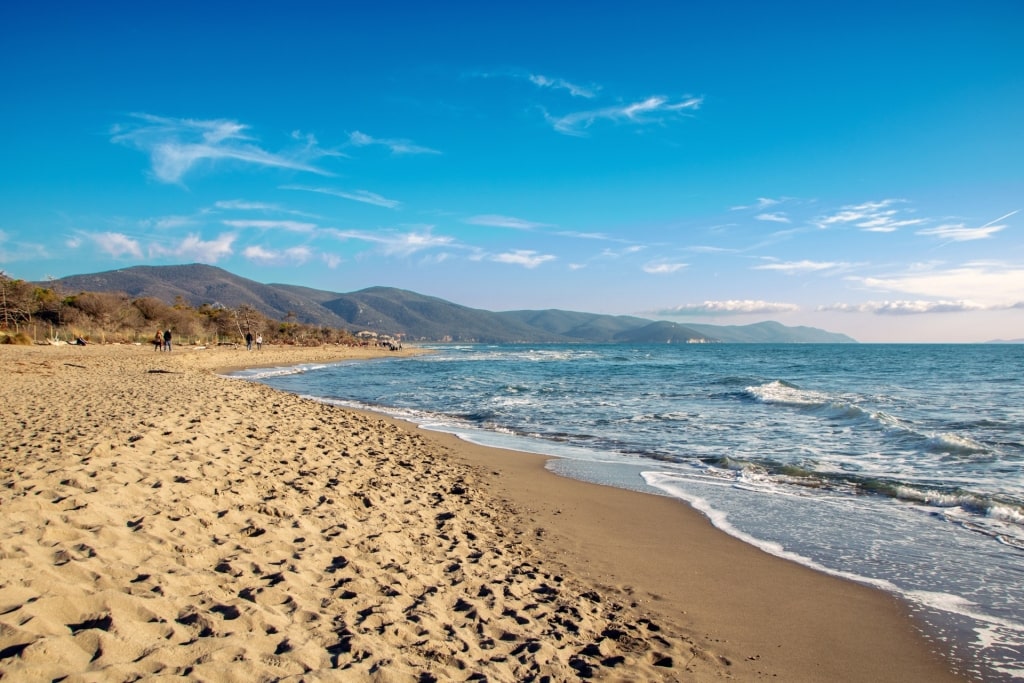
Marina di Alberese in Maremma National Park, near Civitavecchia
The Tuscan region of Italy has miles upon miles of broad, sandy beaches. Much of it, especially in its northern half, is shaded by regiments of candy-colored parasols.
Travel south—especially as far as the wild Maremma National Park—and you reach a less well-groomed coastal scene. Here you find dune-backed beaches at the end of long boardwalks passing over scientifically important wetlands.
Purple herons lift off into the air, bone-white driftwood decorates the bronze sands, and there’s often no one in sight.
That may not be the case at Marina di Alberese beach, the location of maybe the Maremma’s most perfect portion of elemental sand.
Nevertheless, at over a mile long, there’s plenty of space and all of it is free, making it one of the best beaches in Italy for families. Picnic benches are available beneath the welcome shade of the beach-bordering pines.
Poetto Beach, Cagliari
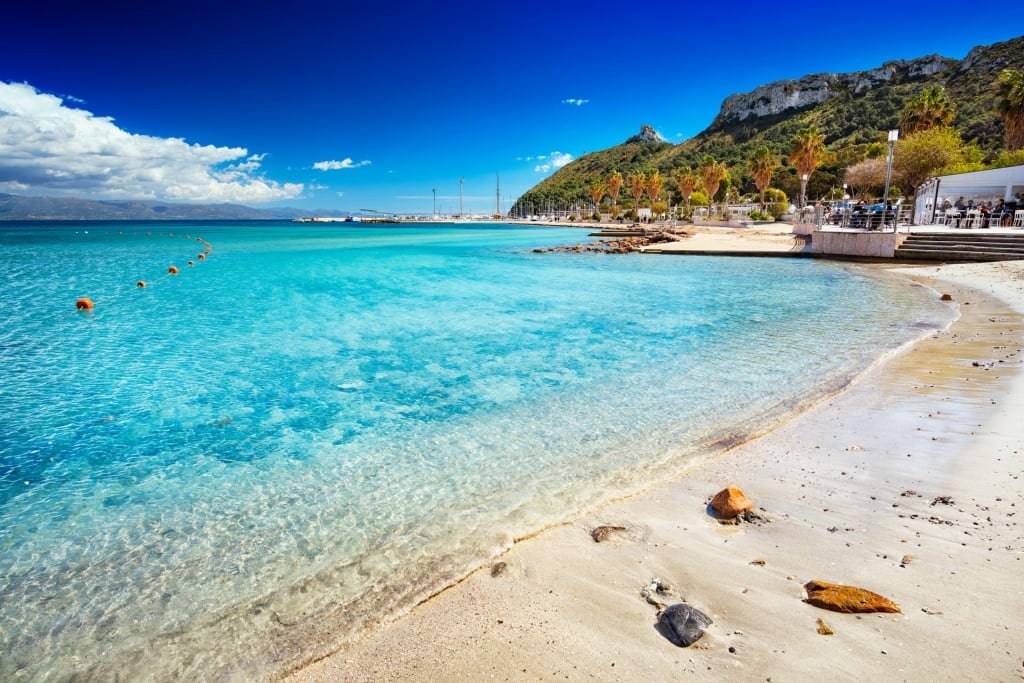
Poetto Beach, Cagliari
Sardinia is blessed with extraordinary beaches and Poetto, the main beach in the capital of Cagliari is one of the best for its good looks, as well as nearby amenities. Notably clean for what is essentially a city beach, Poetto is five miles of white sand bliss strung like a bow between flamingo-strutted salt pans and the beach’s glittering white sand shallows.
Being so splendid and so close to the city, Poetto is never empty, pinstriped with cycle lanes and a kite surfing school at the beach’s southern end. While lounging on the sand under the Sardinian sun, you’ll have a view of the Sella del Diavolo hills projecting out into the tranquil Gulf of Quartu.
Once your stomach begins rumbling for Sardinian cuisine, you’ll find everything from the elegant fish dishes of Chiringuito Lounge Bar & Restaurant to the old trusty Baffo Snack food van and its mammoth fried eggplant sandwiches wrapped in freshly-baked bread.
San Fruttuoso Beach, near Portofino
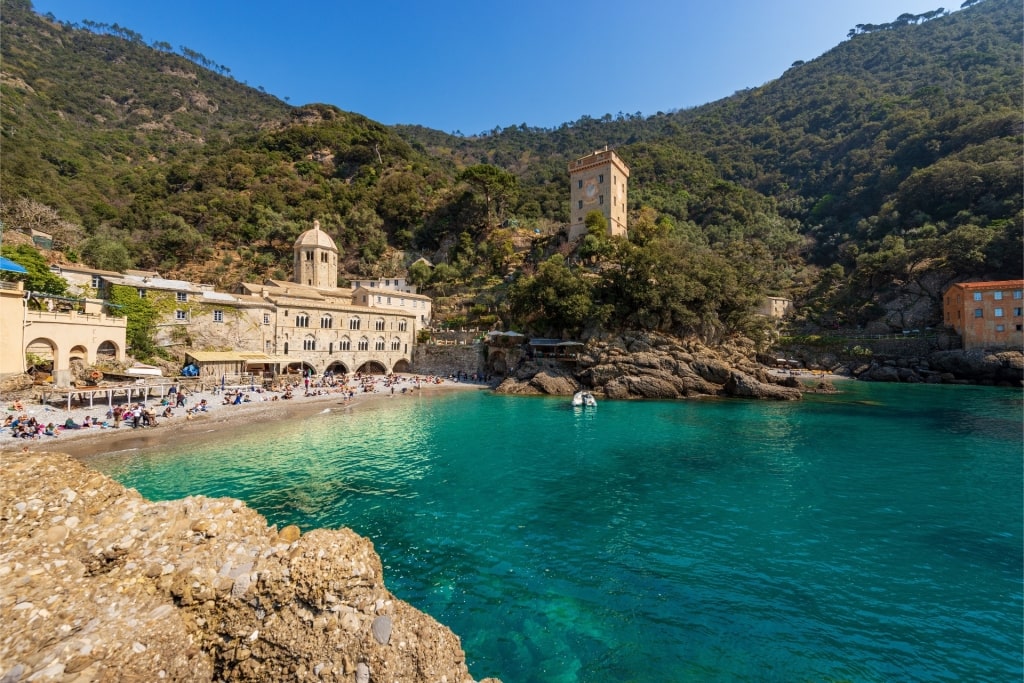
San Fruttuoso Beach, near Portofino
Accessible only by boat, typically a half-hour boat ride from the Italian coastal town of Portofino, or by hiking through the wooded hinterland of the Portofino Peninsula, San Fruttuoso Beach is easily one of the best beaches in Italy.
Its actual pebble beach itself is perfectly pleasant, if a little on the small side. But context is everything here. What makes San Fruttuoso so special is its remote nature and the white-stone 10th-century Abbey of Fruttuoso, with its distinctive octagonal tower, that overlooks the beach.
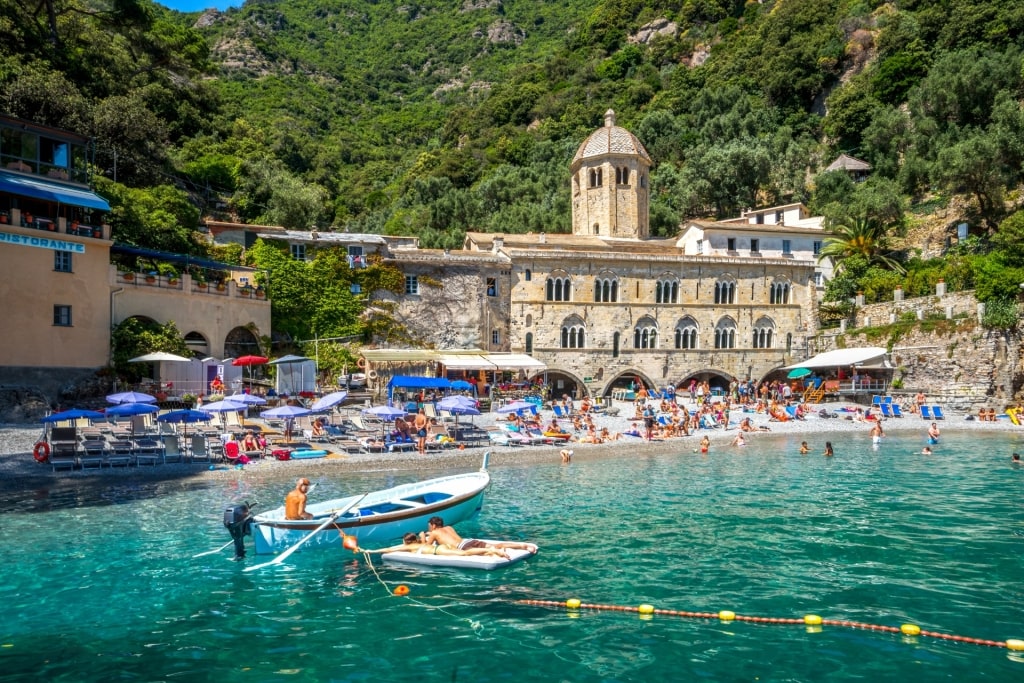
Abbey of Fruttuoso, near Portofino
Once a quiet, contemplative beach upon which monks sat and watched the waves has now become one of the most recognizable images of the Italian Riviera.
Relax on the beach and cool off in the gloriously clear water of the Portofino Marine Park. Just offshore is an underwater statue called Christ of the Abyss that makes for an excellent snorkeling destination. Catch the boat back to Portofino for aperitivi on the quayside.
Chia Beach, Sardinia
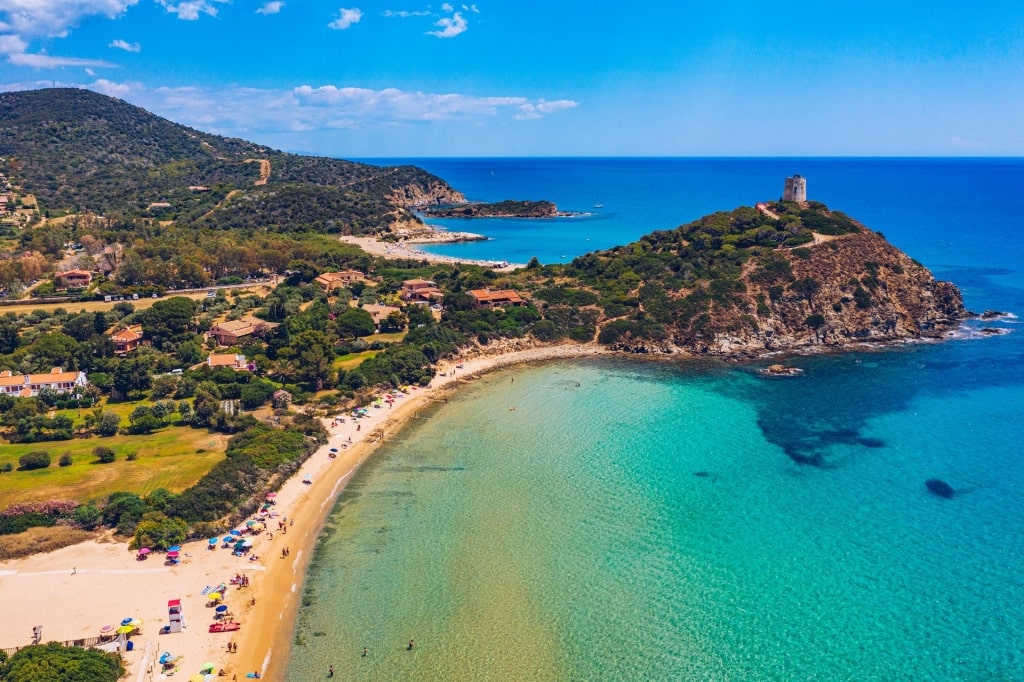
Chia Beach, Sardinia
Make your way through fragrant juniper bushes and onto the warm sand of Chia Beach, one of the best beaches in Sardinia. Of all the world-class stretches of sand enclosed within Chia Bay, on the island’s southernmost tip, Chia Beach is a spacious paradise with warm white sand that turns caramel beneath the waves.
Its northern half, known as Sa Colonia, is arguably the greater destination, mostly due to the nearby cliffs and proximity to some extraordinary historical artifacts. Walk up the sandy path surrounded with rocks clad in mustard yellow lichen and dusty blue scrub over to the headland of Torre Chia, where you’ll find an elegantly ruined Spanish tower. Even more extraordinary are the ruins located at the foot of the promontory that was once part of an 8th-century Phoenician city.
Punta Prosciutto, near Brindisi
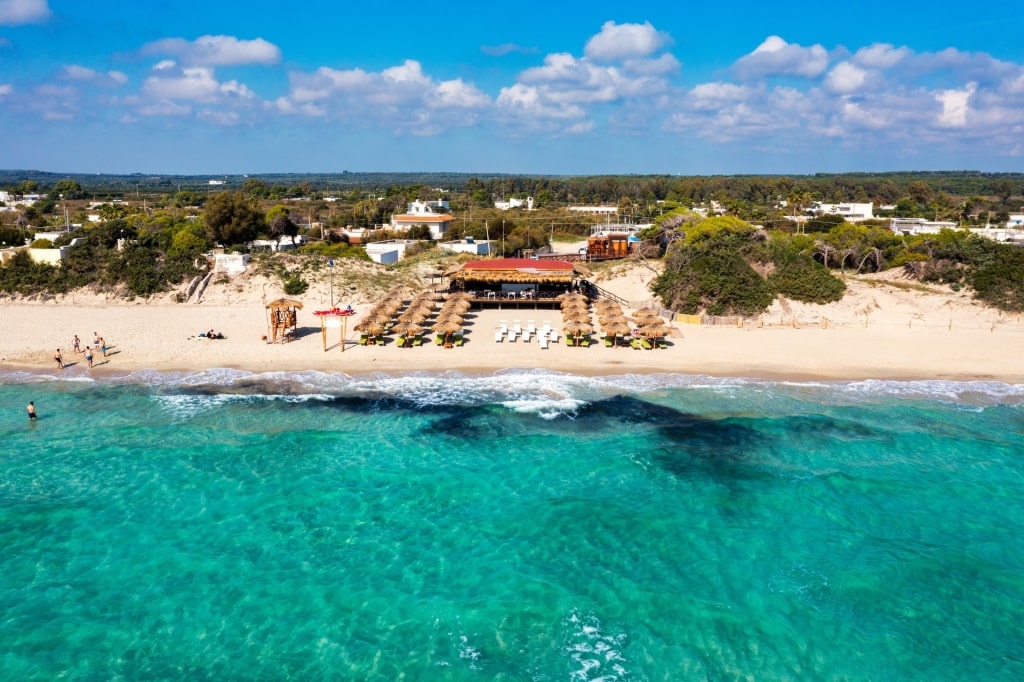
Punta Prosciutto, near Brindisi
A contender for the best beach on Puglia’s Salento Peninsula—essentially the “heel” of the Italian boot—Punta Prosciutto is a gorgeous ribbon of sand with diamond-clear water.
An hour’s drive southwest of the historic port of Brindisi, this beach is hugely popular with families thanks to the water’s cleanliness, sandy shallows, and the good-sized free area in which to pitch a parasol and a cooler. Entering the sea in the summer, it feels like a huge natural swimming pool, with bronzed locals adrift on inflatables.
The beach’s hunger-inducing name is derived from the scrubby, cacti-d point—crisscrossed with dusty paths and popular with local dog walkers—that, from the air, resembles a leg of pork.
Cala Goloritzé, Sardinia
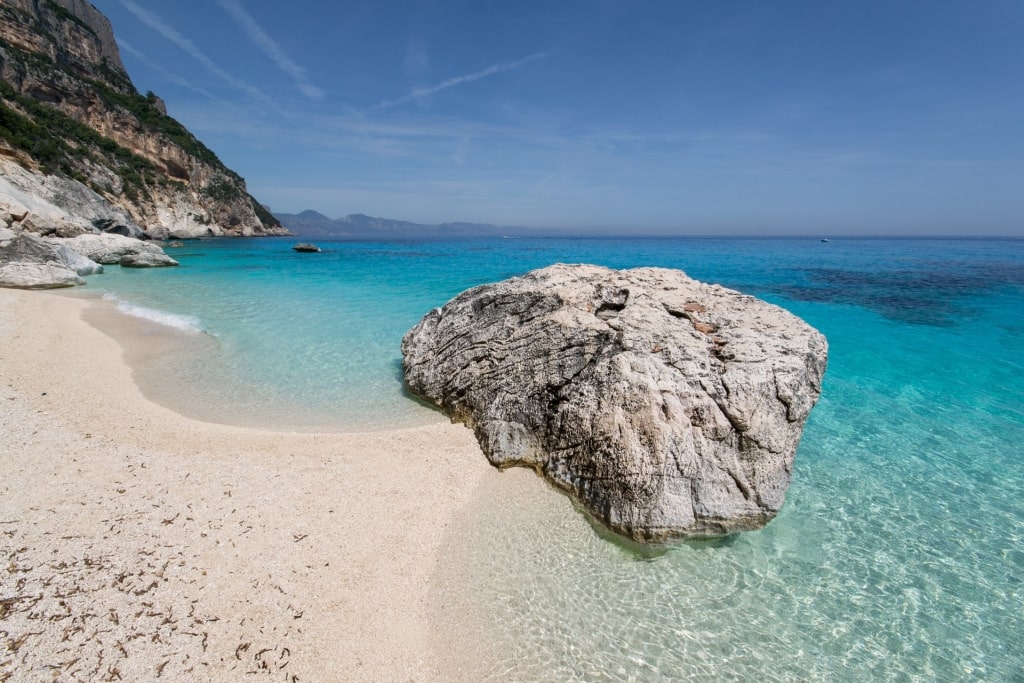
Cala Goloritzé, Sardinia
When approaching Cala Goloritzé—by sea or the cliff path—you’ll notice the famed pinnacle of Aguglia a Tramontana first, a towering natural stone of karst planted to mark this special Italian beach.
Located within the craggy embrace of the eastern Gulf of Orosei, Cala Goloritzé is slightly inconvenient to reach and offers the perfect balance of wild but still comfortable. While tourists may invade its turquoise waters in the summer, the beach is an Italian National Monument, which has a helpful cap on the number of visitors allowed per day.
If you’re not traveling on the water, you’ll have to reach Cala Goloritzé through the five hundred meter path winding through white limestone, weathered oaks, and strawberry trees. But once you arrive at the white pebble beach, with its natural stone arch lowering itself gently into the water, you’ll understand the need for the cap is as clear as the water.
Isola Bella, Taormina
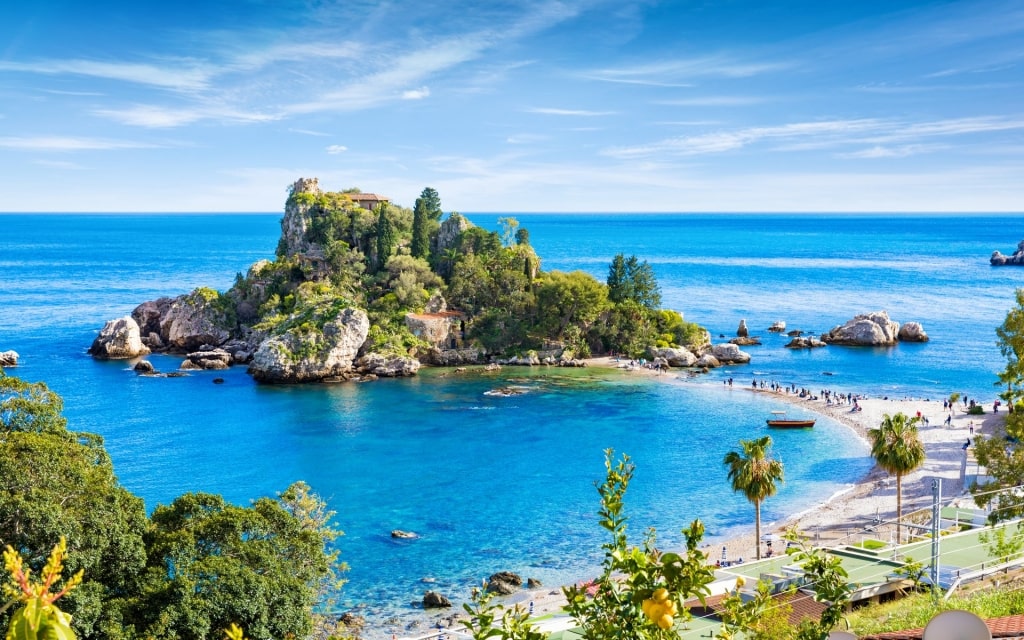
Isola Bella, Taormina
The name for this pebbly beach, which translates as “beautiful island,” at first seems a little misleading. But once you’re there it makes perfect sense. Situated beneath the floating piazzas and bougainvillea-laden hotel terraces of Taormina, the ends of either side of this beach knit together into a white sand isthmus that connects (at low tide) with the verdant islet of Isola Bella.
The island was once the private domicile of Florence Trevelyan, an English exile that was rumored to have been banished to Sicily after having a dalliance with Queen Victoria’s son (and the heir presumptive). A keen gardener, she imported exotic plants to her new home and these are now protected under the island’s status as a nature reserve.
With balmy sea breezes, a romance-imbued islet, and the inviting hiss of the sea through the shingle, Isola Bella is easily one of the best beaches in Italy. There’s also a cable car that whisks you straight to Taormina to ensure you have a cocktail in hand in time for sunset.
Vendicari Nature Reserve, Sicily
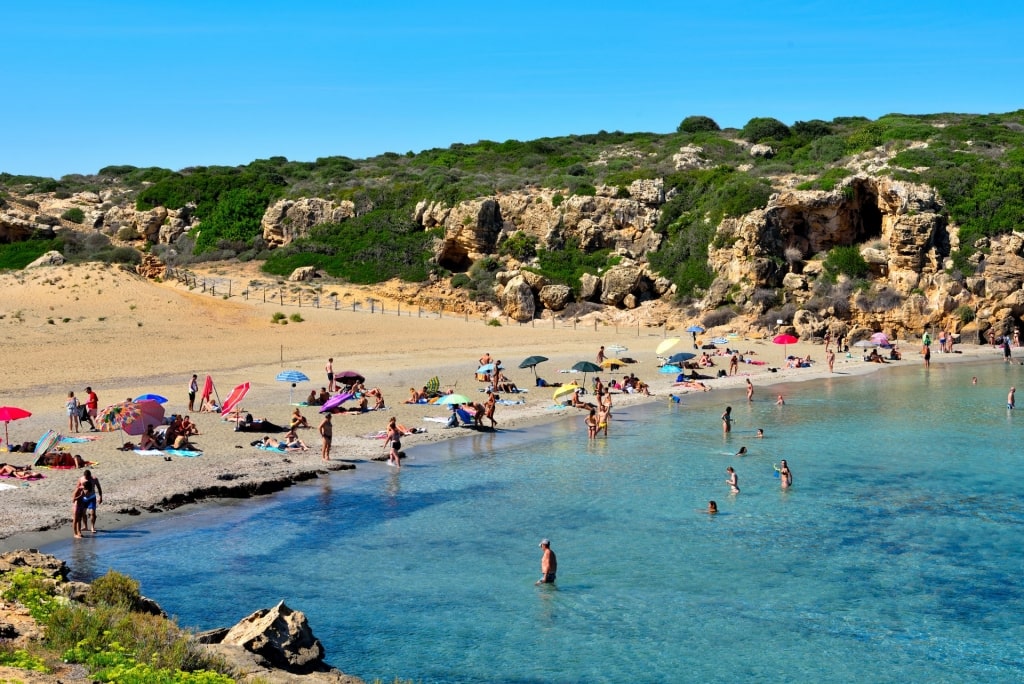
Vendicari Nature Reserve, Sicily
The Vendicari Nature Reserve just south of Syracuse is home to flamingos, rare plants, and some of Sicily’s best sandy beaches.
Of the five, often uncrowded beaches found here, the top pick is probably the golden sands and Caribbean hues of Calamosche. Only about a twenty-minute walk from the parking lot along a terracotta-colored path, you’ll find Calamosche’s silken sands sliding into the shallows waters of a tranquil bay.
And while Calamosche’s charms are hard to resist, the 1,500-acre reserve—home to migrating flamingos, grassy duneland, and some of the island’s most fragrant macchia scrub—is also a wonderful location for a coastal walk. Factor in archaeological remains, which include a necropolis, and suddenly it looks like you might need to push back your dinner reservation.
Read: Best Places to Visit in Sicily
Cala Violina, near Livorno
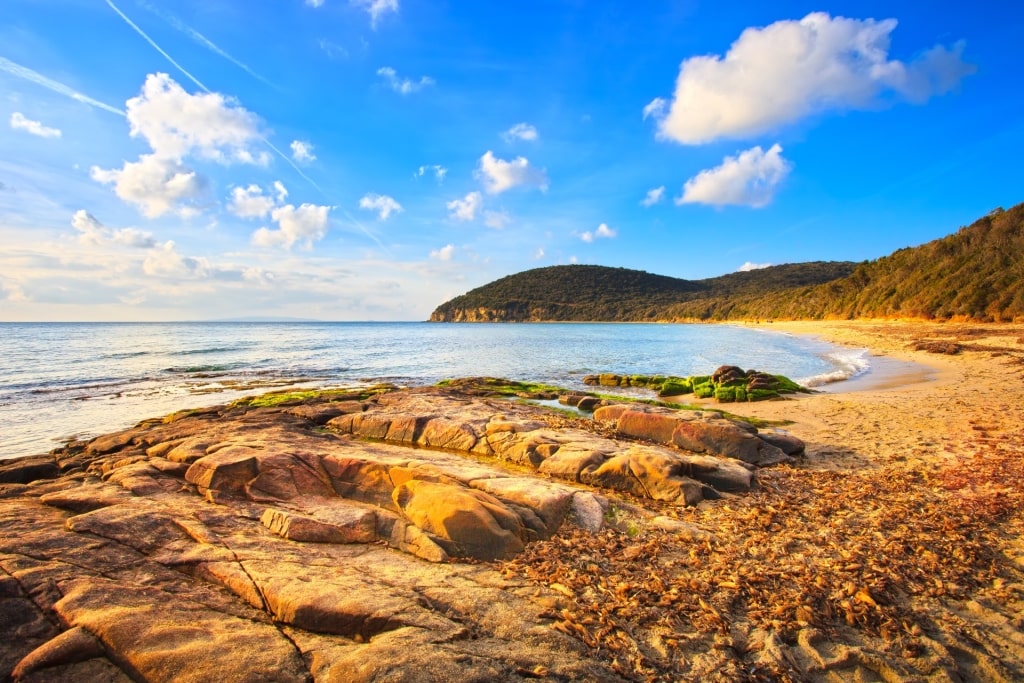
Cala Violina, near Livorno
One of the best beaches in Italy, Cala Violina is a broad wedge of honey-colored sand framed on all sides by verdant hills.
Located within the Bandite di Scarlino nature reserve about an hour and 20 minutes’ drive from Livorno, Cala Violina would be a glorious end to any of the fabulous hikes found within this over 20,000 acres of Mediterranean scrub and woodland. Alternatively, skip the hike and head directly to the beach.
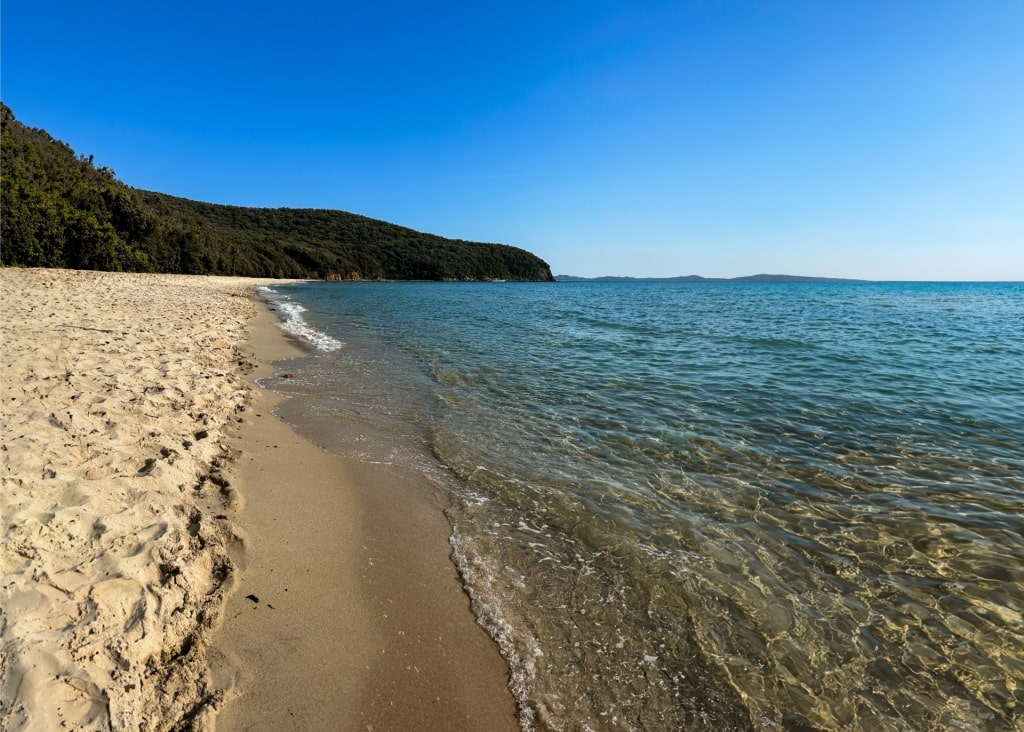
Cala Violina, near Livorno
Cala Violina’s name comes from the violin-like sounds produced by walking on its soft, quartz-derived grains. Silhouetted offshore is the island of Elba, famous as Napoleon’s place of exile, and usually seen in summer through a gauze of sailboat masts jostling for moorings off of this stunning beach.
In high season, be sure to book a visit through the beach’s website 72 hours before arrival. While this beach feels wild, it’s still possible to pick up a refreshing gelato or beer by the beach. If you’d rather not drive, you can hop on a boat from the nearby port of Scarlino.
Scala dei Turchi, Sicily
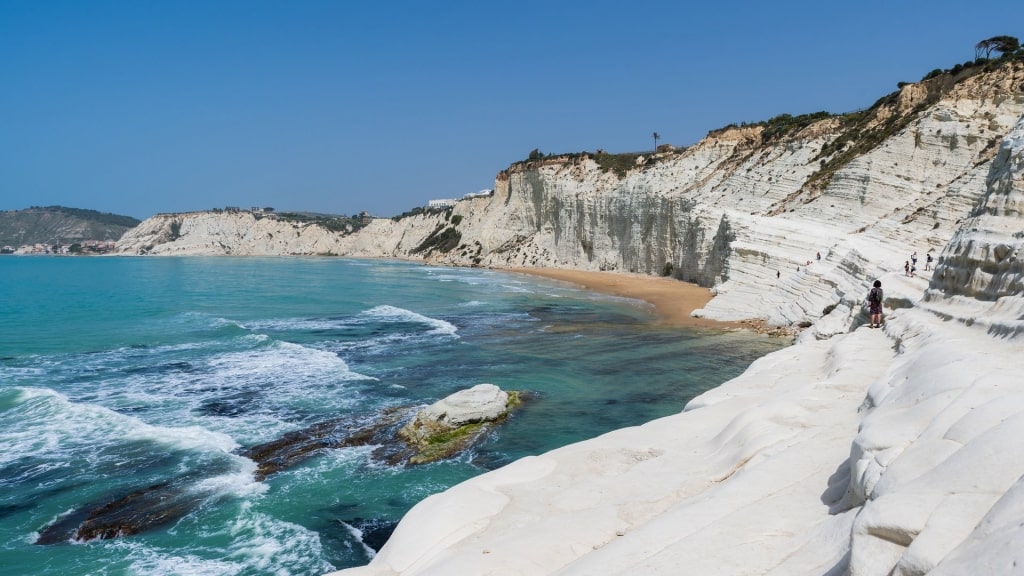
Scala dei Turchi, Sicily
One of Italy’s beaches that seems utterly unique is the Scala dei Turchi in Sicily, a stunning, sloping cliff made of white marl and limestone.
Its name translates as “stair of the Turks” and can be credited to invading Turks, who used to anchor in the bay. Meanwhile, the stair element refers to the remarkably fluid topography that makes this place so appealing. Like a wall of sculpted meringue, sun worshippers gather on the various ledges of this gently sloping spot that offers far-reaching views along the coast.
There’s a sizeable sandy beach adjoining the cliff, although it’s possible to plunge into the warm ocean from the cliff itself, too. With the remarkable juxtaposition of the gleaming, snow-white rock and the azure waters, the Scala dei Turchi truly is a must-see beach. You’ll find it on the south coast of Sicily, just west of Porto Empedocle.
Maiori Beach, Amalfi Coast
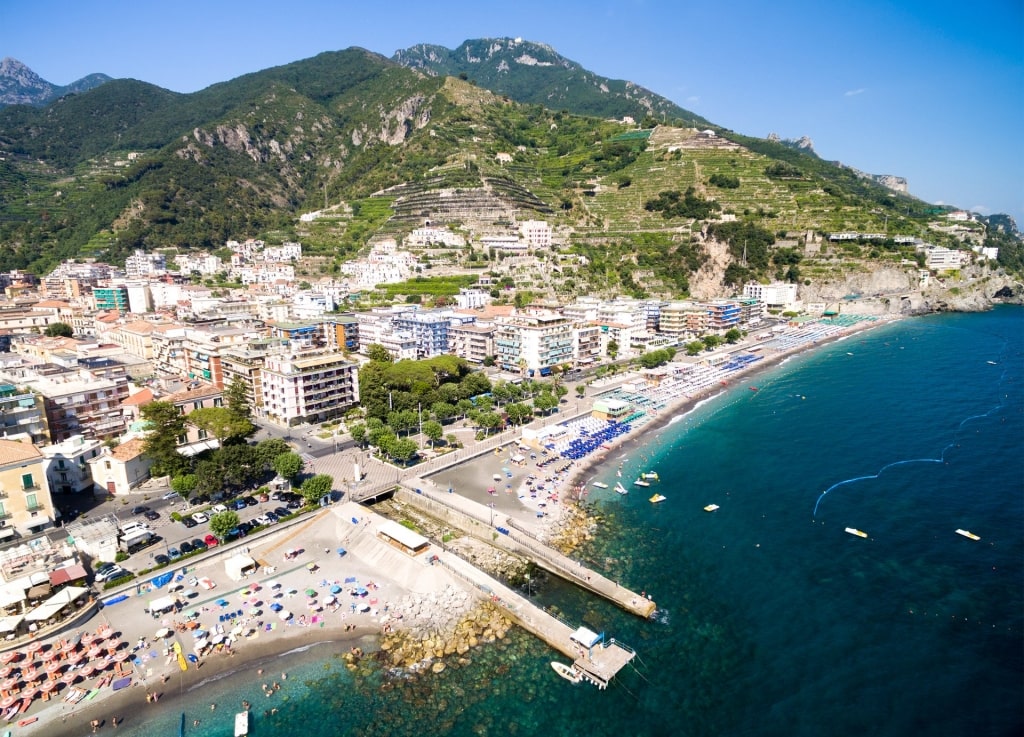
Maiori Beach, Amalfi Coast
What the Amalfi Coast is known for: precipitous terrain characterized by crags and coves, a wiggly highway, and gravity-defying Italian towns. What the Amalfi is not known for: beach holidays.
But that might be because visitors aren’t looking hard enough. In Maiori, a landslide in the 1950s led to a re-shaping of the seafront into a generously proportioned beach. It’s now the longest stretch of sand in the Amalfi and rightfully earns its place as one of the top Italian beaches, as it blends an extremely appealing physical beach with the Amalfi’s almost otherworldly glamor.
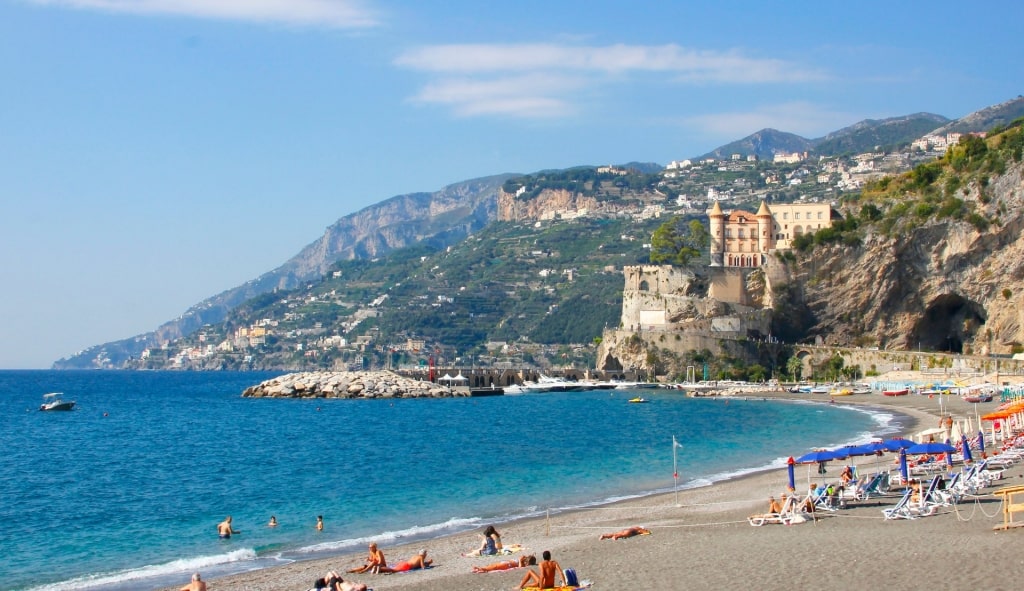
Maiori Beach, Amalfi Coast
This is a sea-lapped spot that welcomes all visitors, from the chic young couples in their classic Fiat 500s to the Italian families on a day out. Hire a lounger or make your way to the sections at either end of the beach, where you can lay your towel wherever you choose.
Afterward, check out historic Maiori. If you’re a fan of Roberto Rossellini, you might have a sense of deja vu after touring its small streets since the Maiori backdrop is featured in no fewer than four of his films.
Read: Best Things to Do on the Amalfi Coast
Giardini Naxos Beach, Sicily
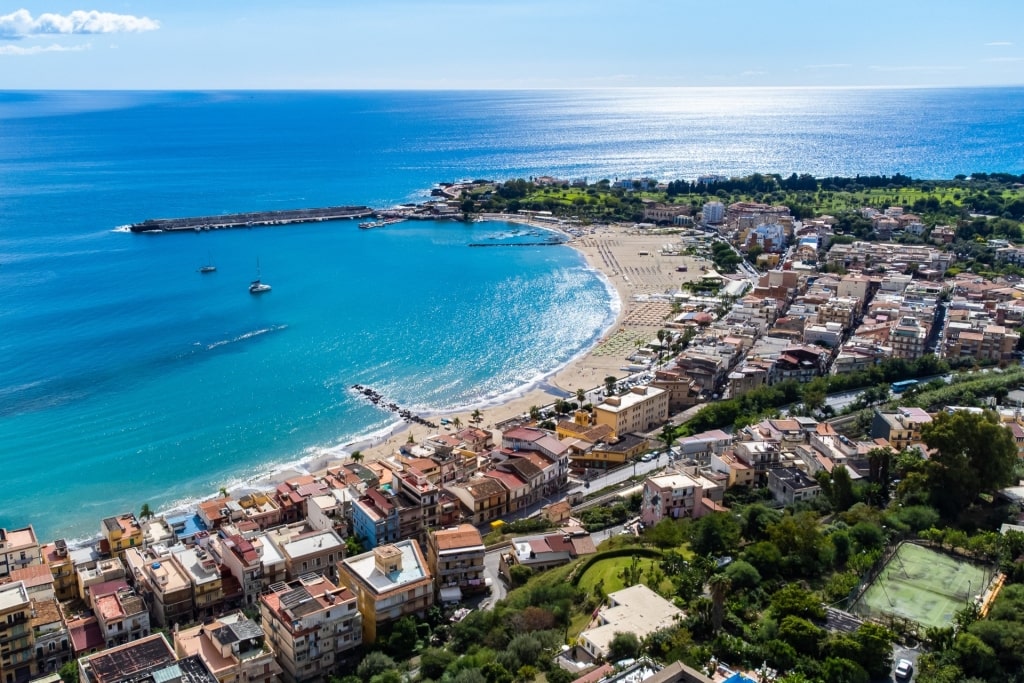
Giardini Naxos, Sicily
A mega swathe of sand separated into smaller segments, Giardini Naxos Beach is the sea-lapped front of one of the island’s largest resort towns.
Just south of the Taormina, Giardini Naxos is a mile-long arc that connects Capo Taormina with Capo Schisò. The beach of Schisò, laid with the finest sand in the area, is considered the nicest section, and is therefore the busiest.
Despite its vast expanse, Giardini Naxos Beach is not one of the best beaches in Italy for a free beach experience. Beach clubs, or stabilimenti, dominate, offering candy-colored parasols, sunbeds, and attendants in polo shirts and aviator sunglasses.
However, on the north side, it is possible to find a narrow area of spiaggia libera close to the San Pancrazio church. Arrive early to ensure a space.
Minori Beach, Amalfi Coast
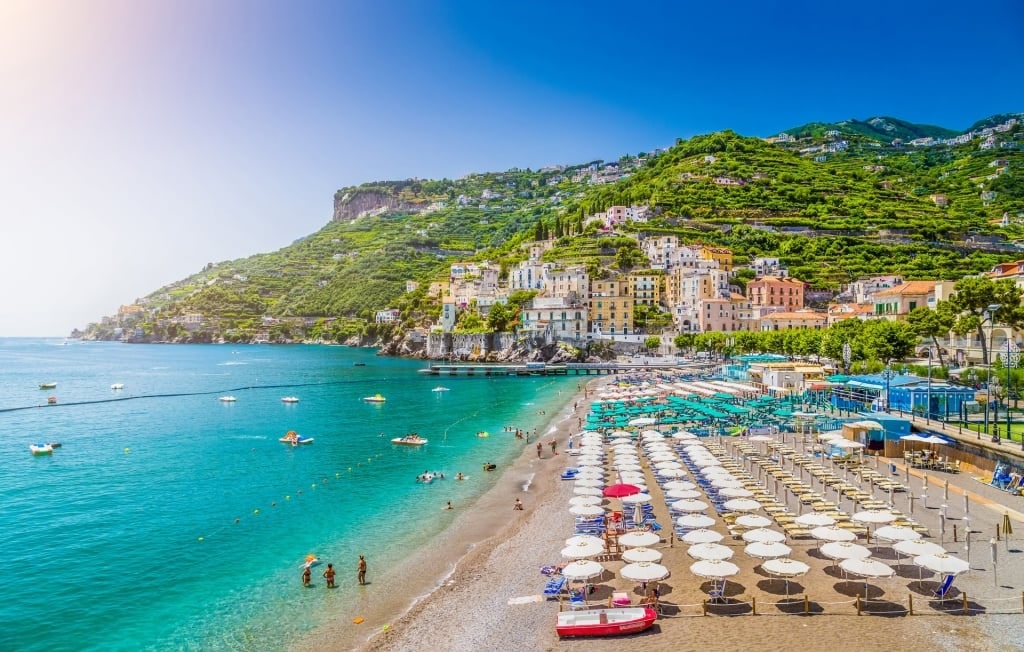
Minori Beach, Amalfi Coast
Minori is the rough diamond of the Amalfi Coast—less self-conscious than its neighbors, and more relaxed for it. Amid its labyrinth of lemon-yellow, peach, and ice white homes, you’ll find a rich heritage of the top-quality gastronomy that Italy is known for. The town’s famed scialatielli pasta, once hung out to dry in floured ribbons in the piazzas, is a must-try with local seafood, while the former ‘King of Panettone’ pastry chef Sal de Riso has a shop and cafe overlooking the sea.
After you’ve gorged on pastries infused with Amalfi lemons, rest upon the south-facing Minori Beach, one of the best beaches on the Amalfi Coast. It’s a shorter stretch of sand than Maiori, but with enough space for you, the fishing boats, and the holidaying Italians that appreciate Minori’s more laid-back, authentic vibe. As the sun begins to set, join the locals for their daily walk along the pine and palm-lined boardwalk or up the town’s short pier.
Atrani, Salerno
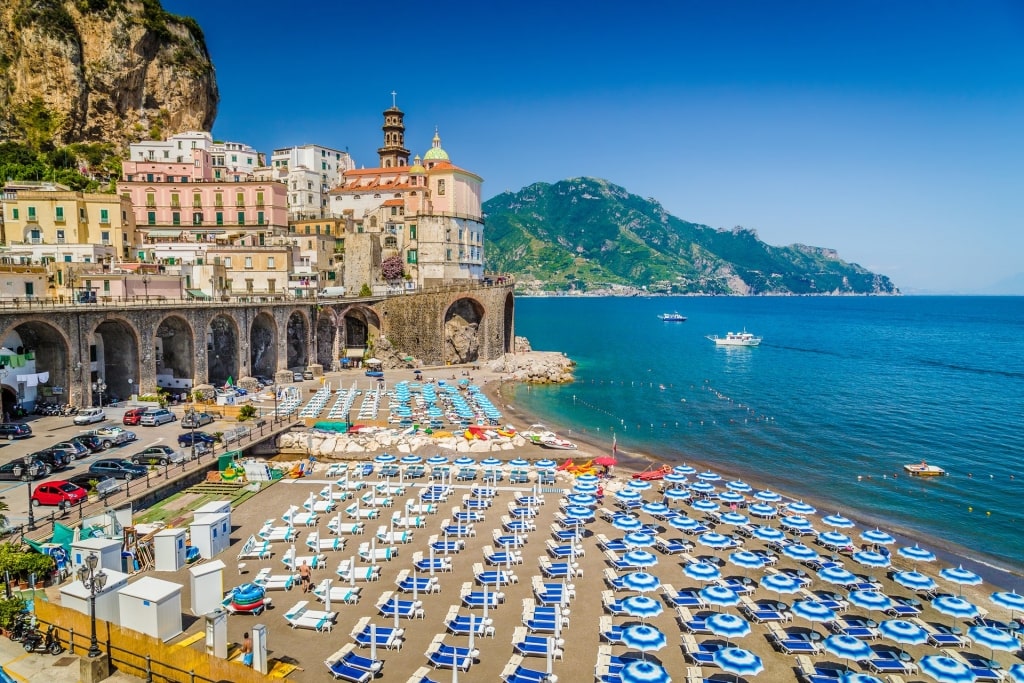
Atrani, Salerno
While the nearby Amalfi might try to take up more of your itinerary, its lesser-known neighbor Atrani—connected by a footpath from Amalfi—is a quieter delight amid the razzle-dazzle of big-name destinations. Better for you that everyone is distracted elsewhere, as Atrani is also home to a little wedge of a beach bracketed by viaduct arches and clear shallows. With so little space, the symmetrical blue and turquoise loungers laid out make one of the best beaches in Italy look almost like a curved step covered in Italian tile.
The clean water makes for excellent snorkeling with bright fish darting out from beneath the undersea boulders. Atrani itself makes for a lovely wander, although if the tiers of colorful houses look like a hard hike, book one of Le Arcate’s tables that overlook the beach instead and explore, with Aperol spritz in hand, MC Escher’s studies of the town from above.
Spiaggia Arenauta, near Naples
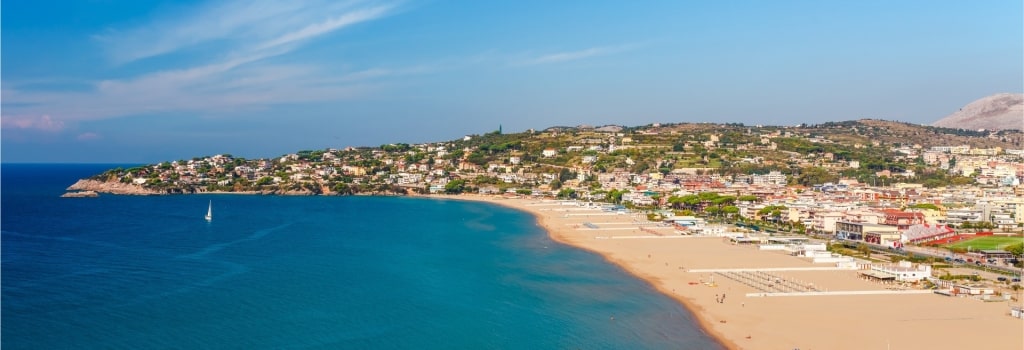
Gaeta, near Naples
A beach on the northern edge of the charming medieval town of Gaeta, Spiaggia Arenauta is a real find, if you can actually find it. With access just off the coastal highway, the most visible signs you’ll see indicating this exquisite stretch of sand is for “L’Ultima Spiaggia.”
There are a lot of stairs to take to reach the bottom, a practicality that helps to thin out the number of Neapolitan families. You’ll pass through a stabilimento that acts like a toll gate to access the barely tended sands beyond. Have at least three euros in cash per person as the card machine reception can be patchy.
But once you’re through, you find yourself on a pristine beach backed by high, scrubby cliffs. Glassy waves roll off a sandbar just offshore, fishing rods are planted in the sand, and a watchtower marks the southern headland. It’s quiet, clean, and sensational.
Read: Best Beaches In & Near Naples
Camogli Beach, near Portofino
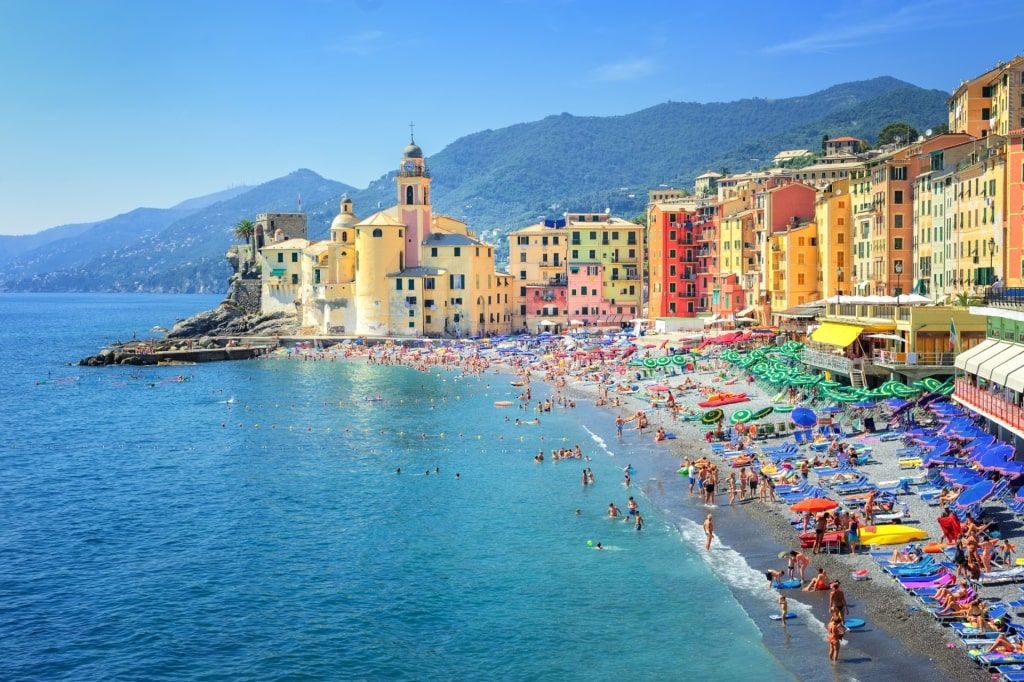
Camogli Beach, near Portofino
The Italian Riviera, also known as the region of Liguria, has over 200 miles of coastline. The overheated Milanese in particular enjoy these beaches—such as at Sestri Levante or Alassio—that offer the space necessary for a city emptying of its inhabitants.
But looking past the larger beaches to the quieter ones beyond can often be beneficial. One of the Riviera’s most characterful beaches is the one found in Camogli. A modest grey pebble shoreline, it’s the center of life in this small, under-the-radar gem in Italy.
Backed by the old town’s blush-colored bell tower and Camogli’s signature lemon-yellow architecture, this beach is a perfect slice of authentic Ligurian life. After you’ve soaked up the atmosphere, wander into the lively lanes for a sundowner and a slice or two of focaccia.
Forte dei Marmi, near Livorno
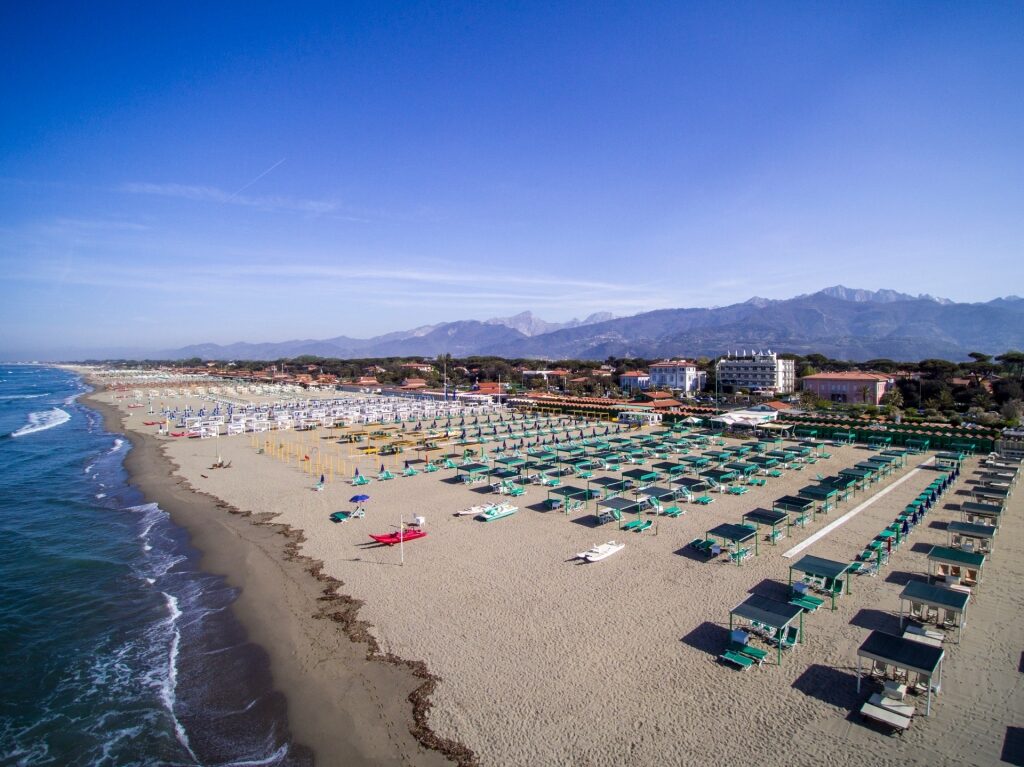
Forte dei Marmi, near Livorno
Tuscany’s Tyrrhenian coastline is one of the country’s most popular vacation destinations. With the region’s famously alluring hinterland and extraordinary cultural heritage, it’s little wonder that some of the heights of seaside exclusiveness are found here.
The resort town of Forte dei Marmi, backed by the dramatic Apuan Alps, is where Tuscany gets fancy. It’s located on the same broad band of soft sand that made Viareggio to the south a famous resort town since the 17th century. Forte dei Marmi came into its own in the Roaring Twenties, a little more boutique, a little more exclusive.
Michelin-starred chefs ply their trade in the beachfront hotels while in summer, the broad beach is divided up into luxury stabilimenti and the long evenings are soundtracked by famous DJs. Off-season, it’s less busy and still one of the best beaches in Italy on which to unroll a towel.
Positano Beach, Positano
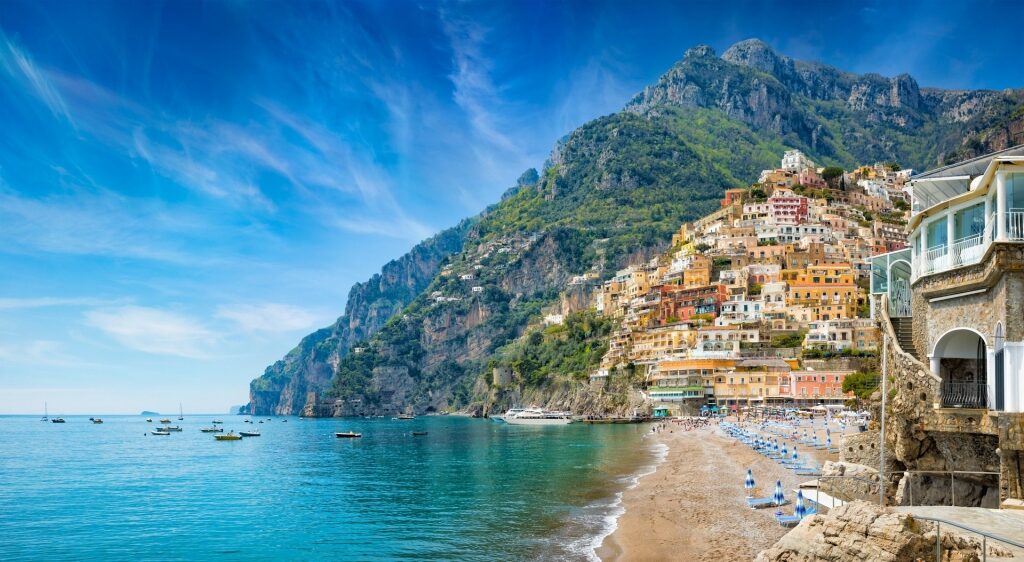
Positano Beach, Positano
Positano, the region’s most emblematic town—and the first to import bikinis into Italy—is a pastel cascade of buildings tumbling down to a broad, gray-shingle beach. While the view of yachts cutting across the sparkling Tyrrhenian seems like the obvious choice, you’ll be tempted to turn your lounger around and gaze at the extraordinary architectural staircase behind you instead.
With such name recognition, Positano Beach is something of a destination in the summer (it’s also the only part of town without any steps to conquer). Visitors come to gather/pose/observe by the water’s edge, or refresh at the numerous bars and restaurants nestled between the pines and fluttering wisteria. Despite the jet-set cachet, the beach feels relaxed, especially amid the free middle section.
Spiaggia di Cala Pira, Sardinia
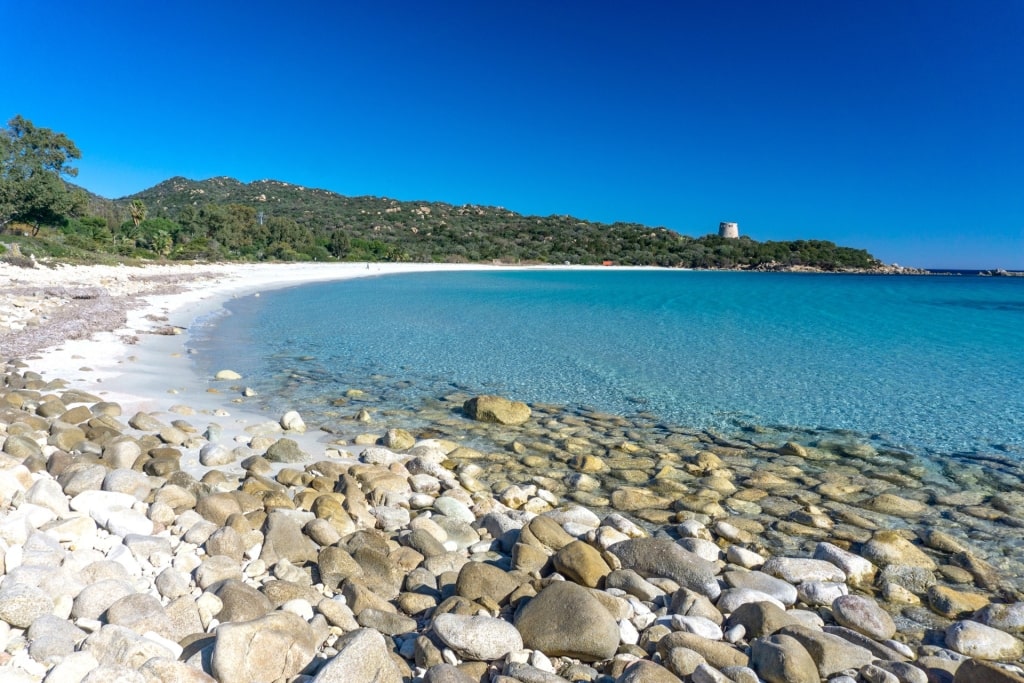
Spiaggia di Cala Pira, Sardinia
Visit Sardinia and you’ll discover how the island takes picture-perfect beaches up a notch. Home to an impressive concentration of the best beaches in Italy, this central Mediterranean island is over-endowed with dramatic sea cliffs towering above serene white shores.
A case in point is the Spiaggia di Cala Pira, essentially the first thousand or so feet of a shimmering eight-mile band of seaside perfection in the Castiadas region. Backed by grassy dunes, the beach is also overlooked by the Cappuccino watch tower situated on one of the verdant headlands. Sailboats and pedalos bob offshore in the aquamarine sea.
To arrive at the beach, you wander past the fibrous trunks of fragrant junipers and leaning pines until you step onto the warm, talcum powder sands. Offshore lies the craggy outline of the island of Serpentara, its profile distinguished by several ruined watch towers.
Viareggio Beach, near Florence/Pisa
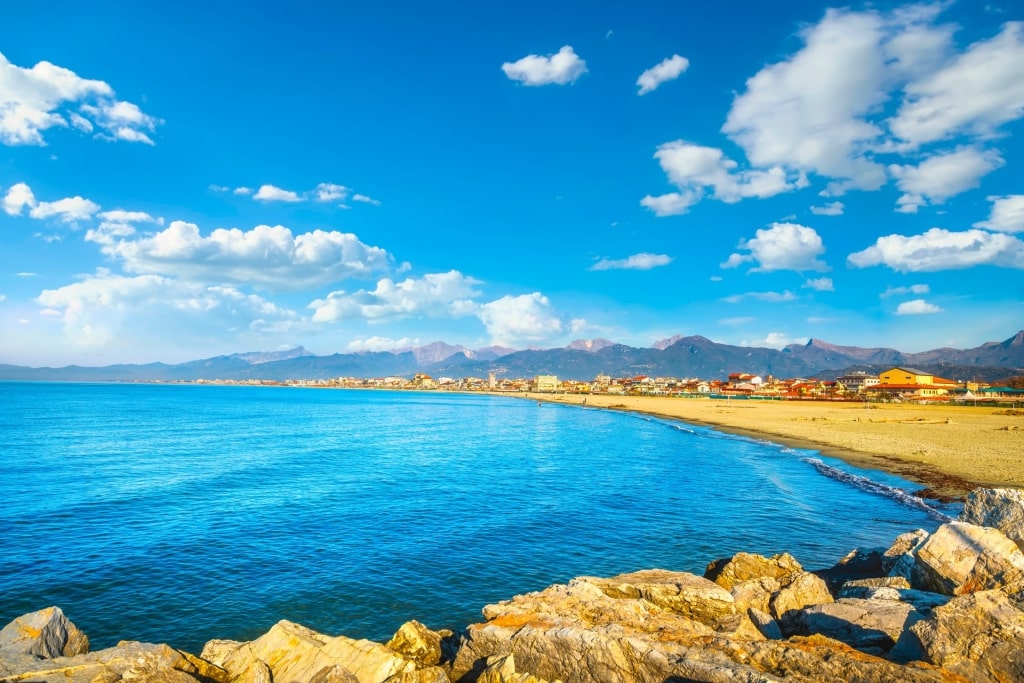
Viareggio Beach, nr. Florence/Pisa
Viareggio Beach, overlooked by the lush Apuan Alps, has long been one of Tuscany’s best beaches. It belongs to the eponymous 18th-century resort town famous for its gigantic Carnevale floats, the composer Giacomo Puccini (he lived there), and the elegant art-nouveau facades of its downtown (the gorgeous Grand Caffe Margherita was where Puccini scored his espresso).
Its epic beach is part of a huge stretch of sand lining the Tuscan coastline. Viareggio’s golden portion is six miles long and features a pointillist parade of striped umbrellas fluttering in a warm, jasmine-scented sea breeze. At the southern end of town, there’s a superyacht shipyard, while the north side of the boardwalk has been modernized with chic cafes and restaurants close to the sand that allow you to see the fishermen in the waves who supply the fresh ingredients for your bowl of cacciucco.
Spiaggia di Sabaudia, near Civitavecchia
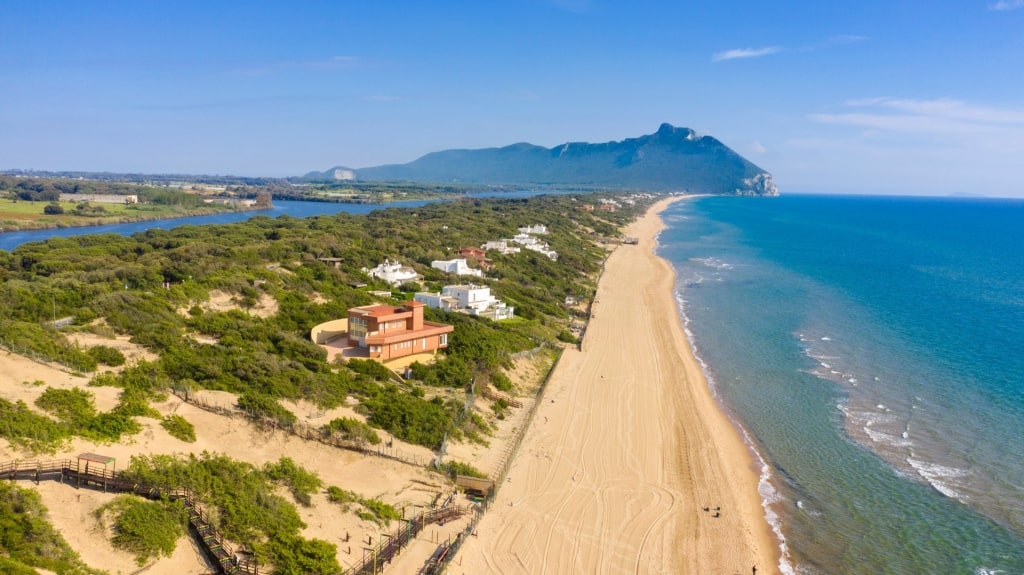
Spiaggia di Sabaudia, near Civitavecchia
Just north of the beautiful beach of Sperlonga is Sabaudia. An evergreen favorite with families arriving from scorchingly hot Rome in August, Sabaudia is spacious enough to contain entire city blocks.
Set on a long straight tongue of land, Sabaudia has wooden walkways leading through the grassy dunes and onto the sandy beach. To the south, Monte Circeo rises dramatically. The water here is turquoise and clear in the shallows, changing to light azure as you wade into deeper water.
Behind the beach are agriturismi and camping sites where families hole up in good value accommodation. Travel south for more upmarket places to visit in San Felice Circeo, a gorgeous walled town, perched near the peak of Monte Circeo.
Torre Lapillo, near Brindisi
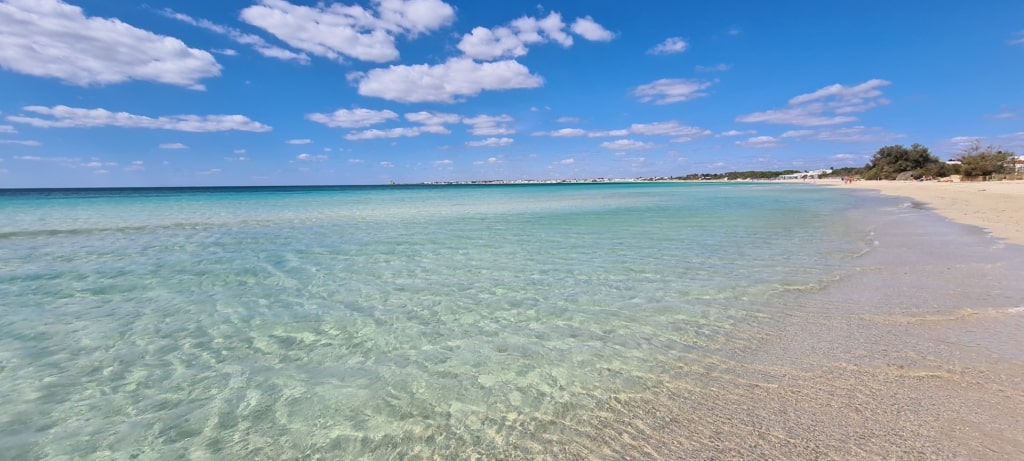
Torre Lapillo, near Brindisi
You’ll find some of the best beaches in Italy on Puglia’s southern coast. Far from the oversubscribed shale and pebble shores of the Amalfi Coast or Liguria, the Ionian Sea’s warm waves lap spacious sandy beaches.
Torre Lapillo, regarded by many as the finest beach in the Salento region, is a prime example of what to expect here. Gilding the seafront of Torre Lapillo, it’s a gently curving crescent of dove-white sand, over a mile long. During summer in Italy, the expansive, translucent shallows fill with families.
Sunbeds and parasols can be rented, and offer a refuge from the busier areas of the beach. At the beach’s northern end, a short walk brings you to the well-preserved Torre di San Tommaso, with its dramatic arched entryway.
Paraggi Beach, near Portofino
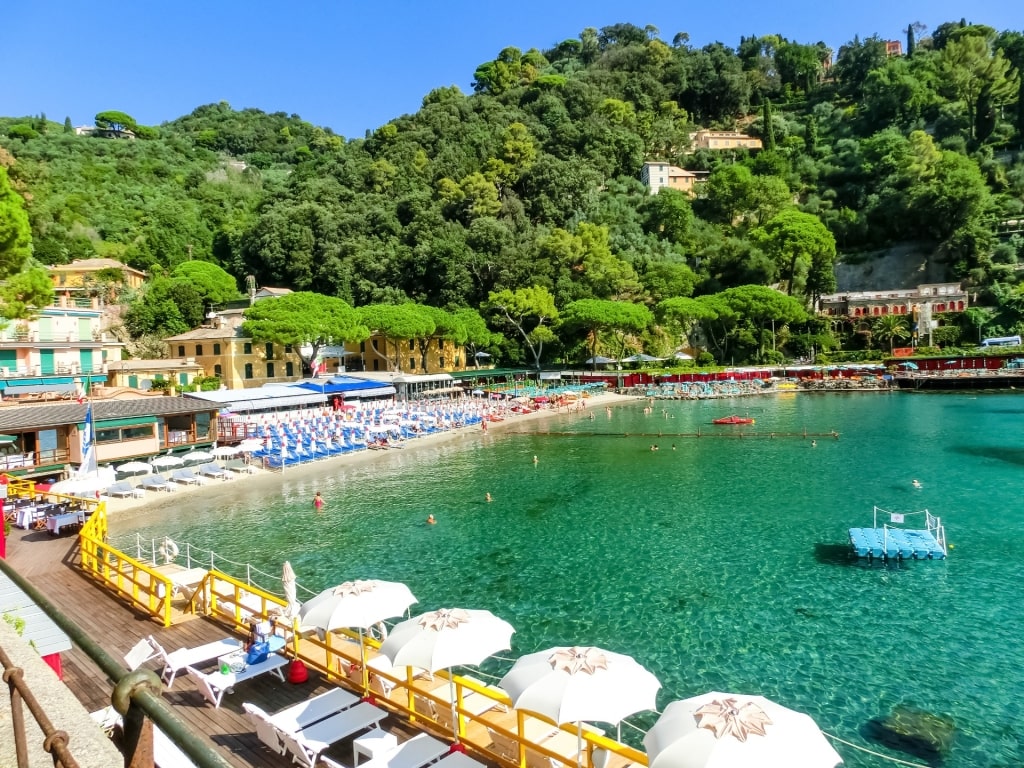
Paraggi Beach, near Portofino
Paraggi Bay is exclusivity heaped upon exclusivity. Not only is it the nearest beach to Portofino, but it’s also one of those rare spots on the Italian Riviera with actual sand.
Paraggi is a hamlet reached after a beautiful coastal walk from Portofino’s cobblestoned quay. Its namesake small bay is defined by emerald shallows and the leafy headlands that reach out into the Blue Flag waters of Portofino Marine Park.
Despite its fame—and the armada of yachts moored offshore—it feels like a find. Either pay a premium for sunbeds at the beach club or see if you can squeeze into the sliver of spiaggia libera. If you’re a diver, it’s worth taking time to explore the area offshore, with its flourishing biodiversity and seagrass meadows.
Spiaggia Marina Grande, Capri
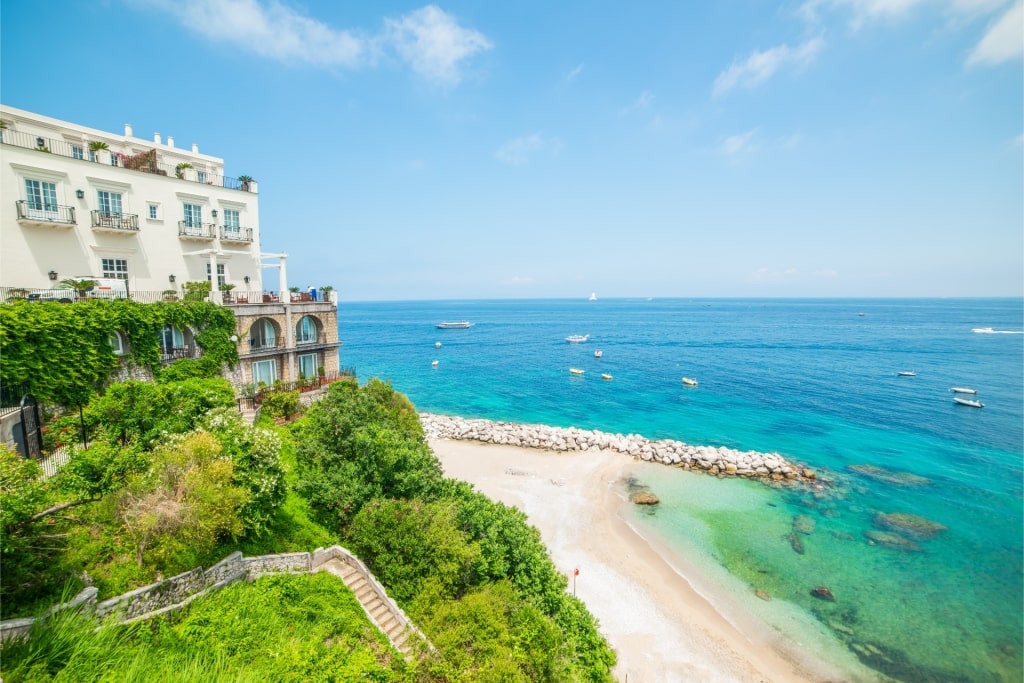
Spiaggia Marina Grande, Capri
If you’re on a trip to Campania—the region that includes Naples, Sorrento, and the Amalfi Coast—a beach day on the island of Capri is something you should seriously consider.
While most visitors to the island do whistlestop tours of the island, few take the time just to relax and soak up the local vibe at the Marina Grande. Here, at the only port on the island, speedboats and superyachts offer endless eye candy, and where better to watch them from than the island’s largest beach, Spiaggia Marina Grande.
Sheltered by cliffs and a breakwater, this thin pebble and sand beach is lapped by glassy breakers. Boulders protrude up from the cat’s eye-green shallows, from which tanned teens leap into the water.
The pastel-painted town sits just behind it, so it’s a short hop to pick up a cone of fritto misto before returning to the glorious sea and mountain views.
See the Bel Paese’s ravishingly beautiful beaches for yourself on a cruise to Italy and discover its shimmering coves, translucent surf, and well-serviced pedalos. Browse our cruise itineraries online and book a memorable vacation to a destination of effortless glamor.
